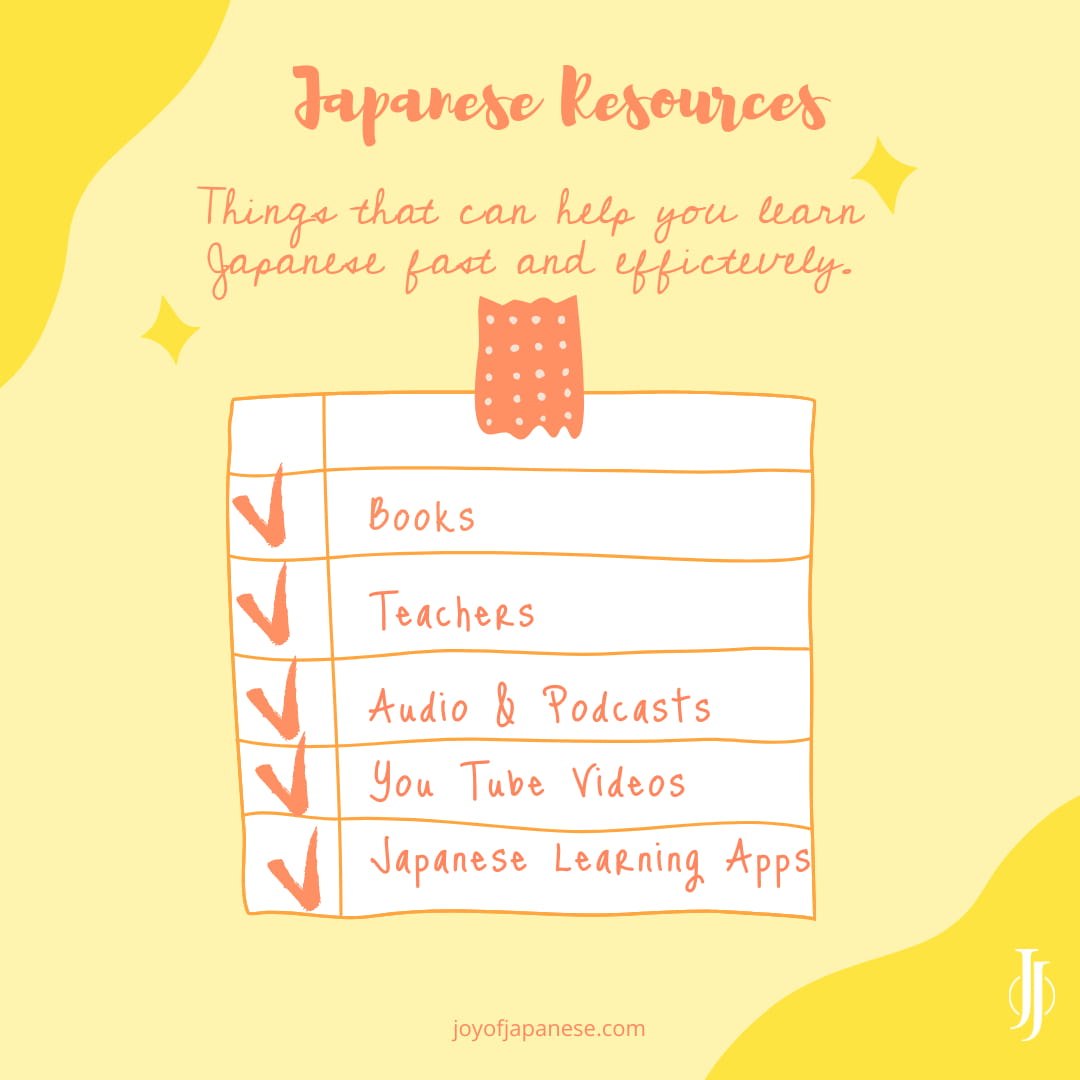If you have been learning the Japanese language or want to start soon, you might ask yourself: How long it takes to learn Japanese?
This is one of the most requested and tricky questions for Japanese learners.
You’ll want to know when you’ll get there, right? It’s an honest question!
How can we begin our long and arduous journey when we don’t know how long does it really take us to become fluent in Japanese?
The answer, of course, is complex since many factors are involved. So the short answer is, “it depends,” which no one likes to hear.
The time to learn the Japanese language relies on many aspects.
Your mother tongue, technique, learning style, goal, time devoted, and other elements can affect the answer. And, of course, the difficulty of the Japanese language itself.
This ultimate guide will help you find everything you need to know. So now, let’s get started!
TABLE OF CONTENTS
- Language learning is always challenging
- 4 key factors affecting the time to learn Japanese
- Tools and Tips that can speed up the learning
- Final Words: Time to learn Japanese
Language learning is always challenging
Language learning is exciting and delightful. But it is also a life-changing decision that demands time, commitment, and hard work. There is no shortcut.
The learning curve becomes steeper and more intense when the language is tough. Examples include Arabic, Japanese, Korean, Mandarin, and Cantonese.
Most learners need to pay more attention to the timeframe to achieve any meaningful level in the target language. And it often requires more time than they estimate.
So, it will be best to have realistic expectations about what you can do and how long it will take you to learn.
Your dedication to that purpose, learning attitude, and passion take years of effort. It is, thus, essential to consider all aspects.
Imagine you have good reasons for learning Japanese. If so, you will be motivated to remain persistent and overcome the challenges it may bring.
You may stop moving ahead at some point if you don’t have firm reasons. Likewise, finding time to review pending lessons may challenge without a plan and zeal.
You will also quickly lose interest and might quit after a while, usually within a few months. It’s unlikely you’ll learn much Japanese, anyway. Because of this, most people do not advance beyond the beginner’s level.
Do you still need convincing?
Just look at how many people are learning Japanese. Check how many can speak Japanese fluently and do Japanese language-related jobs.
Teaching ESL in Japan, for instance, would involve talking with locals. So there won’t even be 1%.
Thus, you should always have a language goal and be inspired to fulfill it. Now let’s talk about this in minor detail.
4 key factors affecting the time to learn Japanese
The time to learn a new language, like Japanese, depends on various factors.
This includes your enthusiasm, language difficulty, mother tongue, and the Japanese level you want to gain. And of course, how you study!
Let’s explore this further!

1. Your native language
Your mother tongue plays a vital role. Learning a new language is easier if your first language is like the one you are studying. This is because of the ability to transfer knowledge from their native tongue to the new one.
The closer your target language is to your native tongue, the faster you can learn.
For example, a Japanese student will probably take much longer to become fluent in French than someone from Spain, Portugal, or Italy.
Likewise, those who speak Chinese or Korean can learn Japanese more quickly than those who know other European languages.
These East Asia languages share a lot of vocabulary, syntax, and writing systems. Again, it is due to geographical proximity and historical root.
But don’t get carried away since Japanese is a language isolate. It implies it has no connection to any known language or language family. Knowing any tongue doesn’t help much when you study Japanese.
You will surely benefit if you have a prior understanding of one of the far east Asian languages. But don’t count them as notable. You still need to learn from scratch and put all your action and effort into getting a higher level of Japanese.
Sometimes, carrying over knowledge from the first language might lead to blunders or interference in the second language. This is especially if the languages are sufficiently diverse.
2. Japanese is a complex language
All languages are hard to learn to vary degrees. Yet, they are not all equally challenging. Some are trickier than others.
According to a US Department of State study, Japanese is one of the most difficult languages for English native speakers to master.
This is because it has fewer structural parallels to English and is unique. Plus, there is a striking difference in structure and sound between Japanese and other languages, including English.
Also, the three alphabets, Hiragana, Katakana, and Kanji, make it longer to memorize.
Japanese grammar and particles are easy to understand. Yet, verb conjugation is the most critical part of grammar and needs more work to grasp.
That is why FSI classified Japanese as a “Super-hard language.” To sum up, Japanese is one of the most difficult languages for English speakers.
They estimate that reaching Japanese fluency takes 88 weeks or 2200 hours. On the CEFR charts, that’s roughly B2/C1 level, JLPT N2 level, or Q2 of NAT test.
Once we add the suggested 1:1 self-study and classroom study. Then, the total time increases to 4,400 hours if your goal is at an advanced level.
According to various estimates, it takes 3000 to 4800 hours of suggested study for N1, which is near-native. This is for English-language students or non-Asian students without prior Kanji knowledge.

3. Immersion and your surrounding
Students who genuinely wish to learn a second language. E.g., being immersed in a community where that language is spoken only, are motivated to learn it rapidly.
Immersion works well. It is because living in the place where you are learning the language is very helpful. Even though I understand that not everyone can afford to live in Japan.
Many people who come to Japan intending to do that have to concede that it is more complex than it seems.
If the opportunity to live in Japan arises, it would be a perfect method. But it is a mistake to believe that this is the only method to learn Japanese truly.
First, because many people will want to converse with you in English. You may not comprehend complex discussions, which may be irritating.
This will only make your learning faster than you now have a compelling reason and thus boost motivation to reach your goal more quickly. Also, being around people who speak Japanese daily will make your skills jump to a new height much quicker.
The pandemic brought chaos. Meetings, schooling, jobs, and other activities can be conducted online, but humans have adapted to these new platforms.
It would be possible to hold online language exchange sessions. It is unnecessary to live in Japan to learn Japanese.
Practicing speaking with your language partner via video or voice calls can vastly affect your abilities.
Many Japanese learning apps can help you find such skills. For example, HelloTalk, Tandem, and one-to-one tutors on Italki, Preply, Verbly, etc.
The best way to learn a language is to live in the country of your target language. But you can benefit from engaging in conversation and actively enhancing your language skills.
While at it, you might find some people to practice with. Take advantage of the ever-connected world, be proactive, and find like-minded learners.
4. Your learning resources
The first thing any Japanese learner searches for is textbooks. Japanese students have access to plenty of new and great material.
Regardless of your study, you will find fantastic resources online. The list is endless, from audio and video lessons to e-books and podcasts. You can find plenty of study materials for Japanese proficiency levels.
Added to all this is how you decide to learn the language and what sources or learning methods you use.
Such as the level of immersion in the language, the books you use, and the amount of listening practice you get. And, of course, the authenticity of your exposure to the language.
These significantly impact how much time is taken to learn a language. The more involvement and exposure, the faster you know. Japanese, a popular language, helps you find tons of help everywhere, online and offline.
Tools and Tips that can speed up the learning
The methods to learn Japanese, or any language that matters, are endless. But choosing the one that works best for you will help you learn faster and better.
You could try the traditional method of language training centers or institutes. They would teach you, starting from the basics, and cover all the aspects through their disciplined schedules.
You can also try studying online language courses offered by websites where native speakers or language professors upload structured lessons.
You can try the software or mobile apps developed to teach Japanese. Their game-like interface will make your experience fun and help you keep the information as your senses are well-engaged.
Another choice is to find a friend who is native Japanese or fluent in Japanese. And they can help you learn the nuances often missed out on in the usual forms of learning a new language.
This is especially true in Japanese, where native speakers often improvise and add their touch while speaking. So, having a Japanese friend can help you catch up on those little details.
Many people must realize the importance of learning the script and the language. Hiragana, Katakana, and Kanji are the three writing systems used by the Japanese to convey their language on paper. Hiragana and Katakana are syllabaries with around 46 characters apiece.
Apart from the usual traditional methods, some extra steps can help make your overall progress faster.

(i) Learning Japanese writing characters
Many people must realize the importance of learning the script and the language. Start with learning the characters, and it will make your journey simpler!
Hiragana, Katakana, and Kanji are the three writing systems used by the Japanese to convey their language on paper. Hiragana and Katakana are syllabaries with around 46 characters apiece.
This will help as a base when exploring the language learning material. Besides, it will give you a definite edge in learning the language faster and better.
There were more characters in the past, but most are outdated and no longer used. On the other hand, Kanji is a collection of around 2000 Chinese characters, each with a distinct meaning and pronunciation.
Hiragana is almost only used to write Japanese-only or Japanese-only spoken words. For example, the phrases “loan” and “foreign,” not native to the Japanese language, are written in Katakana.
Furigana, little Hiragana, or Katakana characters next to each Kanji character, are commonly found in children’s books and Manga, Japanese comics. Furigana stories can help you learn popular Kanji.
Pictographic scripts, such as Kanji, are used in writing. Each sign, or Moji, represents a notion rather than a sound. It is, hence, possible to read or pronounce these symbols.
Kanji workbooks can assist you in learning to write and interpret Kanji characters. So get a workbook and set aside a little time each day to practice, even if it’s just 20 minutes.
(ii) Making use of Japanese entertainment
In a more fun way, you could watch TV shows, movies, or anime to help you learn the language. This needs some caution and precision to make the process efficient and ensure some actual learning instead of just listening to the shows passively.
J-drama, J-pop, films to learn Japanese, karaoke, and music are other forms of entertainment that can enhance your learning process.
As your Japanese improves, consider changing the English subtitles to Japanese while watching TV and films. Your spoken Japanese will increase, but you still must focus on reading.
A similar method is to listen to podcasts or radio shows in Japanese. It will teach you the language in a daily conversation and contextual manner and help you improve your pronunciation and communication as you get a lot of listening practice.
You can link many spoken words with Japanese subtitles when you watch flicks and TV series for Japanese learners. If toggling between Japanese and your native tongue, say English subtitles proves difficult at first, try flipping back and forth.
Regarding vocabulary, look for everyday words you would need if you lived in Japan and master those first. This will make your learning faster and more valuable, as you now have the basics in a good grip.
You must also keep a constant source of listening for your language learning. It could be as podcasts, music, audiobooks, or radio shows.
Combining this with reading through the transcript of the shows is sure to speed up your progress.
Given all this, relying solely on one learning method and one source will take you only a little up the scale.
Thus, it is vital to incorporate the learning process into your daily life besides just textbook learning.

(iii) Learning Japanese grammar rules
Japanese grammar can take some time to get adjusted to. For example, many European languages, like English, follow the Subject/Verb/Object (SVO) pattern.
In contrast, Japanese follows the Subject/Object/Verb. Most Indian languages also follow the same SOV pattern.
Many European languages have a speech pattern stressing the syllables. But the Japanese use a different way to focus on the rising or falling pitch.
Also, the Japanese language and culture emphasize formal and informal speech patterns. And that is why honorifics play a critical role.
Formal conversation (Keigo in Japanese) must be used when speaking to a stranger or older. Yet, a casual tone can be used with friends or juniors (Kudaketa Nihongo in Japanese).
With immersion and focused learning methods, learning Japanese becomes comparatively fast once you get past these. You will be motivated to advance if you have a goal, like jobs involving Japanese.
Final Words: Time to learn Japanese
It goes without saying that Japanese is hard for an English speaker to learn. Besides its complexity, it is also time-consuming.
Look at how children learn a new language. Through constant interaction, they absorb information.
Kids don’t care about language problems as long as they’re within reach. The problem is they are unaware of this until they become semi-fluent.
There is no doubt that learning takes a long time, but that is how they master any language. Consistency and time that’s all you need! You can’t argue with logic!
The time taken to learn this language can be generalized only to a certain extent. The specifics depend on your strategy, speed, and availability.
You can achieve the same results with the correct method, persistence, a strong will, and motivation. You don’t need a rocket scientist to figure this out!
In the end, what matters more is your commitment to learning the Japanese language regularly rather than how many hours you practice. Of course, having the right strategy and guidance is just the cherry on top!
How many hours a day should you study Japanese?
That is subjective and depends on your dedication, schedule, and purpose.
If you are learning as a hobby, 15 to 20 minutes is fine. In 5-6 months, you can hold a few minutes of talks and easily read many texts.
What if you need the JLPT N4 score for higher study in Japan? Then, one year of study will be adequate.
The timeline also differs, depending on how much you study regularly. For example, 30 minutes of daily study will take 3 to 5 years to get to an upper intermediate level.
If you can’t wait that long, you must study more. E.g., 10 to 20 hours of weekly study. This can cut your journey to N2 into two years.
And it would be best if you keep going and don’t quit midway. One day, you will get there. Following the proper steps and put your efforts will ensure you will be successful learners sooner than later.
How long does it take to learn Japanese fluently?

To be fluent in Japanese is about how easy and accurately you speak Japanese.
Fluency doesn’t always mean perfect and eloquence, like native speakers. On the contrary, it is when you speak confidently and relax with a few mistakes.
An old language like Japanese is vast, and no one, including Japanese experts, knows everything about it. Yet, they have Japanese language skills to do all the work.
As per my talk with many Japanese teachers, specialists, and learners, fluency in Japanese takes a freaking long time.
The average time to learn Japanese may vary. It depends on the level you wish to attain, your approach, and the time you spend. And if you study independently, your progress may take more time.
Usually, you will get the fluency or advanced level in 3-5 years. After that, you can get Japanese translator jobs, interpreters, or higher-level teachers.
In the end, learning a second language is a lifetime process. We don’t even know everything about our native language, either.
It will take less time if you intend to communicate daily in Japanese. So a few months!
For maximum learning outcomes, center on quality and not just quantity. The Pareto principle, where 80% of outputs (results) come from our 20% inputs (causes), can help.
So, do not worry! Armed with a proper study plan, motivation, and enough interest, any language is within your reach. And Japanese is no different!
I hope you enjoyed reading this article. If you want to share your views or ask questions, write in the comment below.







